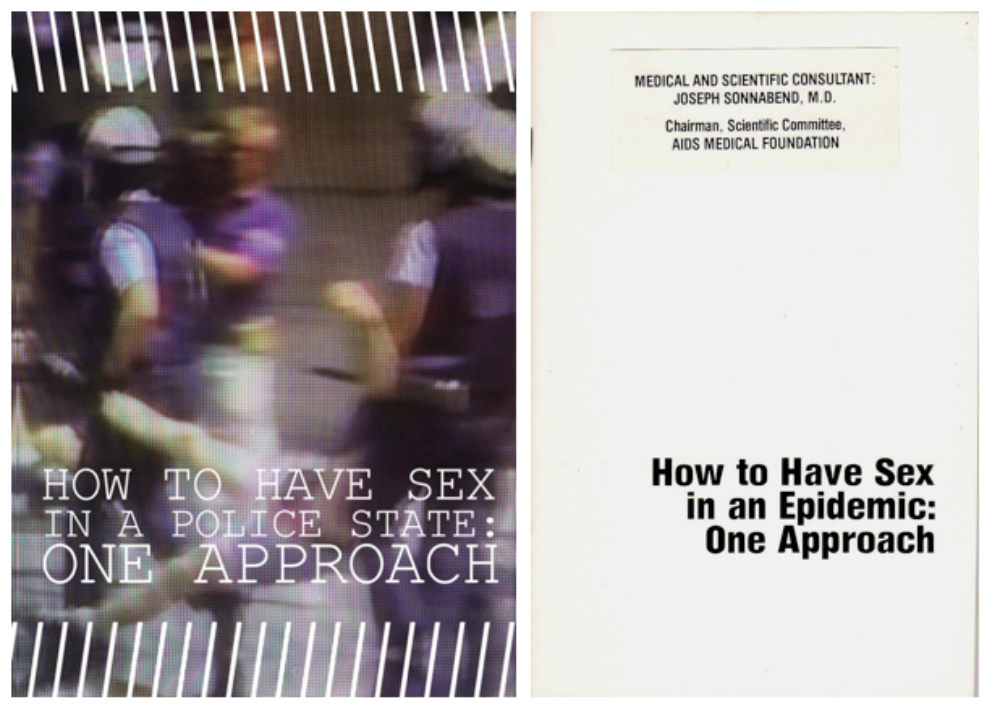HOW TO HAVE SEX IN A POLICE STATE:
Our Approach
By Richard Berkowitz and Joseph Sonnabend, MD
People living with HIV and AIDS (PWAs) have played vital roles in shaping the earliest responses to the epidemic. The main reason was simple. We had to: Official and institutional responses were slow to develop.
From the invention of safe sex to the establishment of several organizations, people with AIDS played crucial roles. Our work on safe sex was made even harder because segments of the LGBT community initially opposed our approach.
As it was then, the criminalization of HIV has prompted PWAs and their supporters to take matters into their own hands: They have been doing so for many years with some limited successes. It is a complicated and difficult issue that is remarkable for the extent to which many who should be concerned and involved remain uninformed or silent.
A new publication from an anonymous group of Canadian activists confronts the explosive issue of HIV criminalization by offering useful, sensible ways for Canadian gay men to protect themselves from the long arm of the law.
If the title of their booklet, HOW TO HAVE SEX IN A POLICE STATE: One Approach, rings a familiar bell, that was their intent. HOW TO HAVE SEX IN A POLICE STATE begins with an acknowledgement of HOW TO HAVE SEX IN AN EPIDEMIC: One Approach, which we co-authored and self-published with the late Michael Callen in 1983. It’s always wonderful when subsequent generations of activists acknowledge the efforts of those who came before them. As was the case with HOW TO HAVE SEX IN AN EPIDEMIC, HOW TO HAVE SEX IN A POLICE STATE is a truly grassroots initiative, capturing the “do-it-yourself” spirit of the original booklet.
In looking at the history of AIDS activism it’s possible to recognize two distinct and opposing trends. The first, which could be called “confrontational activism,” starts with the premise that historically, society at large has never displayed particular concern for the well-being of its minorities, whether they are ethnic or sexual. With this in mind, there’s a realization that minority communities have no choice but to take responsibility for their own protection. This is what we understood to be the meaning of self-empowerment. We knew that the interests and priorities of PWAs could be at odds with those of some research scientists. We live in a world that is still capable of cruel and discriminatory behavior towards minorities. Who better to protect the interests of those who had the most to lose than people living with AIDS themselves?
On the other hand, what may be called “collaborationist activism” turns to government and established institutions and accepts without question the scientific and medical directions they set. This way differs from a confrontational approach, which doesn’t unquestioningly accept the scientific leadership of government institutions, and therefore seek the advice of independent experts who can be held accountable. Collaborationist activists feel that their role is to provoke established authorities to come up with solutions, as well as to help them organizationally and with funding, such as trying to get Congress to give them money.
Despite its worldwide acceptance, HOW TO HAVE SEX IN AN EPIDEMIC was met with hostility from influential elements within the community and with indifference by the authorities. The early confrontational AIDS activism, which included the articulation and introduction of safe sex practices, PWA empowerment, the Denver Principles, community-based research and the buyers club movement, were all hallmarks of this kind of do-it-yourself, self-empowered, confrontational activism. Sadly, it didn’t prevail. But HOW TO HAVE SEX IN A POLICE STATE demonstrates that this type of activism is still alive and well.
View and download HOW TO HAVE SEX IN A POLICE STATE here.
Dr. Joe Sonnabend, Richard Berkowitz and Michael Callen formed an unlikely team in 1982, one year after AIDS first came to attention. Joe had started a Greenwich Village medical practice in 1978, specializing in the treatment of sexually transmitted infections. For 20 years before that, his professional life had been spent as a virologist at academic medical centers in the U.K and the U.S. Richard and Michael were patients of Joe's when he introduced them to each other after recognizing that they were both highly motivated to be of help. The cause of AIDS was still unknown, but Joe's experience as a microbiologist and his familiarity with his gay male patients, led him to suggest a multifactorial basis for this disease that stressed the importance of specific infectious agents, particularly those transmitted by semen. The obvious behavioral implication resonated with Richard and Michael and they began to think of ways that could interrupt or avoid the sexual transmission of infectious agents. This culminated in How to Have Sex in an Epidemic: One Approach.
Joe's professional associations allowed him to rapidly assemble a group of scientists interested in researching AIDS. With the support and encouragement of Dr. Mathilde Krim, these researchers formed the nucleus of the AIDS Medical Foundation (later AmFar.) Joe's office contributed to several other initiatives, including the establishment of community-based research, the first Buyers club, confidentiality guidelines, the first scientific journal on AIDS (AIDS Research), and the nation's first lawsuit to ban discrimination against PWAs.
